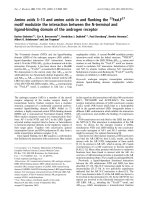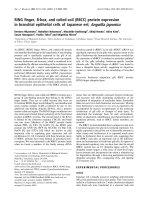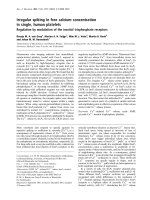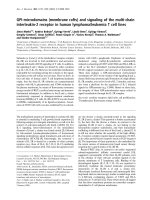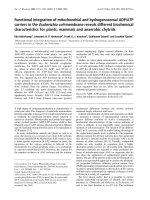Báo cáo y học: "Remote preconditioning in normal and hypertrophic rat hearts" doc
Bạn đang xem bản rút gọn của tài liệu. Xem và tải ngay bản đầy đủ của tài liệu tại đây (986.63 KB, 7 trang )
RESEARCH ARTICLE Open Access
Remote preconditioning in normal and
hypertrophic rat hearts
Christos Voucharas
1,2*
, Antigoni Lazou
2
, Filippos Triposkiadis
3
, Nikolaos Tsilimingas
1
Abstract
Background: The aim of our study was to investigate whether remote preconditioning (RPC) improves myocardial
function after ischemia/reperfusion injury in both normal and hypertrophic isolated rat hearts. This is the first time
in world literature that cardioprotection by RPC in hypertrophic myocardium is investigated.
Methods: Four groups of 7 male Wistar rats each, were used: Normal control, normal preconditioned, hypertrophic
control and hypertrophic preconditioned groups. Moderate cardiac hypertrophy was induced by fludrocortisone
acetate and salt administration for 30 days. Remote preconditioning of the rat heart was achieved by 20 minutes
transient right hind limb ischemia and 10 minutes reperfusion of the anaesthetized animal. Isolated Langendorff-
perfused animal hearts were then subjected to 30 minutes of global ischemia and reperfusion for 60 minutes.
Contractile function and heart rhythm were monitored. Preconditioned groups wer e compared to control groups.
Results: Left ventricular developed pressure (LVDP) and the product LVDP × heart rate (HR) were significantly
higher in the hypertrophic preconditioned group than the hypertrophic control group while left ventricular end
diastolic pressure (LVEDP) and severe arrhythmia episodes did not differ. Variances between the normal heart
groups were not significantly different except for the values of the LVEDP in the beginning of reperfusion.
Conclusions: Remote preconditioning seems to protect myocardial contractile function in hypertrophic
myocardium, while it has no beneficial effect in normal myocardium.
Background
The heart can be protected from an episode of acute
lethal ischemia/reperfusion injury by applying brief non-
lethal episodes of isc hemia and reperfusion either to the
heart itself (ischemic preconditioning = IP) or to an
organ or tissue that is remote from the heart (remote
preconditioning = RPC) [1-3].
Initial enthusiasm for the beneficial effects of ischemic
preconditioning of the heart in animal or human studies
has given place to skepticism, since there has not yet
been broad application of the method in clinical practice
[4]. Controversy still exists about the efficacy of the RPC
in normal hearts, as wel l as about the value of IP in the
hypertrophic myocardium [5-10].
Larger multicenter trials would be required to confirm
the results and novel methods should be employed to
accurately estimate the i nfluence of ischemic precondi-
tioning in cardioprotection.
Moreover, remote precondition ing of the hypertrophic
heart has neve r been studie d before. Moderate cardiac
hypertrophy is a common state of m any physiological
and pathological conditions in humans: exercise, preg-
nancy, hypertension, heart valve disease or myocardial
infarction. We have to note that RPC may refer to the
same organ and to a distant organ or tissu e. Remote
preconditioning of the heart regarding transient i sche-
mia caused to another organ or tissue far from the
heart, has advantage over classic ischemic precondition-
ing or RPC regarding transient ischemia of a region of
the h eart other than the region examined for sustained
ischemia, since it does not compromise the myocardium
[11,12].
This study was designed to investigate if remote pre-
conditioning at a distant organ improves myocardial
function after ischemia/reperfu sion injury in normal rat
hearts and - for the first time in world literature - to
* Correspondence:
1
Department of Cardiovascular and Thoracic Surgery, School of Medicine,
University of Thessaly, Larissa 41335, Greece
Full list of author information is available at the end of the article
Voucharas et al. Journal of Cardiothoracic Surgery 2011, 6:34
/>© 2011 Voucharas et al; licensee BioMed Central Ltd. This is an Open Access article distributed under the terms of the Creative
Commons Attribution License ( s/by/2.0), which permits unrestricted use, distribution, and
reproduction in any medium, provided the original work is properly cited.
examine the action of RPC in hypertrophic rat
myocardium.
Methods
Animals
Twenty eight male Wistar rats were used for this study.
They were randomly divided into 4 groups of 7 animals
each to form normal control (NC = non hypertrophic
myocardium, non preconditioned), normal precondi-
tioned (NP), hypertrophic control (HC) and hyper-
trophic preconditioned (HP) group.
All animals were treated according to the Guidelines
for the Care and Use of Laboratory Animals stated in
the Greek law (160/1991) based on European Union
regulations (European Commission Directive 86/609/
EEC). Furthermore, the experimental protocol was
approved by our Institutional Ethical Committee.
Model of hypertrophy
Hypertensive myocardial hypertrophy was established to
14 animals (originally 2-months of age and weighing
150-200 grams) by concurrent administration of a syn-
thetic mineralocorticoid (fludrocortisone acetate, Insti-
tute for Pharmacological Research and Tec hnology,
IFET, Pallini Attiki s, Greece) and saline for 30 days
[13,14]. Corticoid/salt model of hypertrophy is a pres-
sure overload induced cardiac hypertrophy model. In
this model, hypertrophy is both co ncentric and
eccentric, similarly to hypertrophy in humans [15].
Fourteen more two-month-old male rats were fed a nor-
mal diet for 30 days. At 3 months of age all the animals
(both normal and hypertrophic heart rats) were weigh-
ing 200-250 grams a nd they were ready to undergo the
experiment. Solid alimentation supply was the same for
all animals.
The animals intended for myocardial hypertrophy
were given 12.5 cc of a salt solution with fludrocortisone
acetate (0.9% NaCl, 0.2% KCl, 2.54 mEq % Mg
++
,0.002
mg % fludrocortisone acetate) to drink in place of water
forthefirsthalfofeverydayandafreequantityofa
salt solution (0.9% NaCl, 0.2% KCl, 2.54 mEq % Mg
++
)
for the rest of the day, in order to ensure a standard
corticoid intake o f 0.00025 mg per animal per day. Per
os corticoid administration was adopted instead of sub-
cutaneous injection [10] in order to avoid additional
anxiety and stress to animals because of the injection.
The heart wei ght to body weight ratio was used as an
index of myocardial mass.
Experiment protocol
Animals were anaesthetized by intraperitoneal injection
of sodium pentothione (100 mg/kg). Heparin was deliv-
ered intravenously (300 IU/kg) through the femoral
vein. The right common femoral artery (just below the
inguinal ligament) of the animals that were scheduled to
receive remote preconditioning was exposed and tem-
porarily occluded for 20 minutes. Occlusion was
achieved by a silicon loop tightened by a tourniquet.
Then, circulation to the hind limb was restored for
10 minutes.
Next steps of the procedure were common for all the
groups. The hearts were rapidly excised and placed
immediately in ice-cold perfusion buffer (0°C) before
being mounted on a Langendorff apparatus. The
ischemic time between excision and mounting was less
than 1 min. The pericardium, the pleural cavities and
the peritoneal cavity were at the same time explored for
effusions; the liver weights as well as the lung weights of
the rat s were mea sured in orde r to calcul ate liver
weight/body weight (LiW/BW) as well as lung weight/
body weight (LW/BW) ratio; the aim was to investigate
heart failure. Hearts were retrogradely perfused in an
isovolumetric Langendorff mode at a constant hydro-
static pressure of 100 cm H
2
O during the entire dura-
tion of the experiment. The perfusion medium was a
non-recirculating oxygenated (95% O
2
,5%CO
2
)nor-
mothermic (37°C) Krebs-Henseleit bicarbonate (KHB)
buffer. KHB buffer had the following ion concentrations
in mmol/L: 25 NaHCO
3
, 4.7 KCl, 118.5 NaCl, 1.2
MgSO
4
,1.2KH
2
PO
4
, 2.5 CaCl
2
and 10 glucose (pH
7.4). The perfusion apparatus was water-jacketed to
maintain a constant perfusion temperature of 37°C.
To determine left ventricular pressure, a catheter with
a latex balloon on its tip was inserted into the left ven-
tricle through an incision in the left atri al appendage.
The balloon was tied securely into place and filled with
water to give an end diastolic pressure between 6 and
10 mmHg. The adjusted volume remained constant
throughout the experiment. This allowed continuous
measurement of left ventricular pressures and recording
of their a lterations on a fixed preload. The balloon was
connected to a pressure transducer via water-filled poly-
ethylene tubing. Three stainless steel el ectrodes were
inserted into the epicardium o f both of the atria and of
the right ventricle for three leads bipolar electrocardio-
gram recording. Left ventricular pressure and he art
rhythm were monitor ed continuously and record ed on a
computer. All hearts were allowed t o stabilize for
10 min after being mounted. Baseline measurements
were recorded during this period. Hearts were allowed
to beat spontaneously throughout the experiment.
Lethal or threatening arrhythmias (like ventricular fibril-
lation, tachycardia or bigeminy) at the reperfusion per-
iod following t he sustained ischemic insult were
converted to normal rhythm by tapping the ventricle.
Left ventricular function was assessed by left ventricu-
lar developed pressure (LVDP), end diastolic pressure
(LVEDP) and the product HR (heart rate) × LVDP.
Voucharas et al. Journal of Cardiothoracic Surgery 2011, 6:34
/>Page 2 of 7
Developed pressure is defined as peak systolic minus
end diastolic pressure. In this experimental m odel,
LVDP represents the h eart’ s contractile ability which is
not influenced by preload and afterload.
Zero flow ischemia was induced by clamping of the
arterial line. Sustained ischemia lasted 30 min for all
series. The reperfusion time was 60 min. The experi-
ment protocol is concisely presented in table 1. The
measured values (baseline and then every 5
th
minute
after reperfusion) were committed to paper.
Statistical analysis
NC group was compared to NP group and respectively
HC group was opposed to HP group. Values were
expressed as the mean ± SEM. Two-tailed unpaired t
test was used to compare BW, HW/BW ratio, LW/BW
ratio, LiW/BW ratio, arrhythmia incidents and baseline
hemodynamic data. Regular (not matching) two way
ANOVA was performed to test for any differences
between hemodynamic values (LVDP, LVEDP,
LVDPxHR) measured at various time points and exam-
ine if time point of reperfusion affected the result. Data
in every separate group passed normality test and diff er-
ences between SEMs in compared groups (raw data)
were due to random sampling. A difference was c onsid-
ered statistically significant if p < 0.05.
Results and disc ussion
Body weight (BW) was similar between normal and
hypertrophic heart rats, but heart weight t o body weight
(HW/BW) ratio markedly differed (hypertrophic approxi-
mately 46% in excess) as shown in table 2. Body weight
and HW/BW ratio did not differ between the compared
groups - animals were equally distributed among the
groups (data not presented). There was no evidence of
heart failure in hypertrophic heart animals: no remark-
able cavity effusions in hypertrophic groups and no sig-
nificant diff erence in lung weight to body weight rat io as
well as liver weight to body weight ratio between normal
and hypertrophic heart animals (table 3).
Baseline (stabilization period) values for LVDP,
LVEDP and LVDPxHR did not significantly differ when
control groups were compared to preconditioned groups
as shown in table 4.
All hearts started beating within a few seconds at the
onset of reflow. Thirty-minute sustained myocardial
ischemia markedly affected myocardial function during
reperfusion period in all groups: LVDP was lessened,
LVEDP was elevated and the product LVDPxHR was
reduced in every single group and at any time point of
reperfusion, in comparison to baseline measurements
(figures 1, 2, 3). The differences were very significant
reflecting myocardial damage after the ischemic insult
(data in details not presented).
Myocardial ischemia and infarction alter not only the
contractile systolic properties of the heart but also its
diastolic properties. Elevation of L VEDP against fixed
preload is an i ndication of enhanced wall stiffness of the
heart. In crystalloid perfused hearts, this enhanced stiff-
ness is attributed to the increase of myofibrillar tone
and the so-called erectile or garden hose effect whose
relative magnitude is dependent on the severity of myo-
cardial damage induced by ischemia [16,17].
Remote preconditioning influence in hemodynamics of
normal (without cardiac hypertrophy) rats
Preconditioning did not s ignificantly affect the LVDP
between the normal groups (p = 0.1314). However, time
significantly influenced the values measured (p =
0.0011). As time passed, during reperfusion period, the
preconditioned group retrieved from lower level; mean
LVDP of the preconditioned group exceeded the normal
group mean value after time point 45’ (figure 4). This
reflected the disproportional variation on LVEDP
between the two groups in the early phase of reperfu-
sion (figure 4). However LVDP values were comparable
at whichever time point between the two groups (inter-
action was not significant, p = 0.9006).
LVEDP significantly differed between the two groups
(p = 0.0004) and in addition time point affected the
Table 1 Experiment protocol
Control groups Isolated heart stabilization period
10 min ®
Sustained ischemia 30
min ®
Reperfusion period
60 min
Preconditioned
groups
Limb ischemia 20
min®
Limb reperfusion 10
min ®
Isolated heart stabilization period
10 min ®
Sustained ischemia 30
min ®
Reperfusion period
60 min
Table 2 Body weight and heart weight/body weight ratio of normal and hypertrophic heart rats
Normal heart rats n = 14 Hypertrophic heart rats n = 14 p
Body weight 219.8 ± 3.079 grams 222.9 ± 2.548 grams 0.444
Heart weight/body weight 0.004301 ± 0.0001466 0.006289 ± 0.0002148 < 0.0001*
Body weight did not differ between normal and hypertrophic heart rats, while heart weight/body weight ratio was considerably different. Values are expressed
as the mean ± SEM. The asterisk (*) means statistically significant, p < 0.05.
Voucharas et al. Journal of Cardiothoracic Surgery 2011, 6:34
/>Page 3 of 7
result (p < 0.0001): non preconditioned myocardium was
markedly “stiffer” than preconditioned at the early phase
of reperfusion; however, thirty five minutes later and till
the end of reperfusion period both groups behaved in a
similar way (figure 4); apparently part of myocardial
damage was reversible.
Values of the product LVDPxHR were almost similar
(p = 0.2464) at any time point of reperfusion (p =
0.3931) for both normal groups (figure 4). That was
equally due to LVDP and HR values.
As an overall validation, hemodynamics did not vary
between preconditioned and non preconditioned normal
group in our investigation.
However, several animal studies have shown that brief
ischemia induce d in remote organs, for example, kidney,
intestine, and skeletal muscle, decreased myocardial infarct
size [3,11,18]. One can hypothesize that the 30 minutes of
myocardial ischemia in our investigation was not long
enough to cause large and permanent/irreversible damage
to the heart. During the past 5 years, remote ischemic pre-
conditioning has shown promise in small randomized con-
trolled trials as a means of myocardial protection before
paediatric and adult cardiac surgery and percutaneous cor-
onary interventions [19]. Nevertheless, controversy still
Table 4 Baseline hemodynamics
baseline NC
group
NP
group
pHC
group
HP
group
p
LVDP 82.6 ±
4.23
79.6 ±
2.48
0.5521 91.9 ±
8.36
92.9 ±
6.11
0.9247
LVEDP 9.7 ±
0.74
9.0 ±
0.81
0.8319 10.0 ±
0.38
10.0 ±
0.95
1.0000
LVDPxHR 18664 ±
942
18556 ±
543
0.9225 18944 ±
2216
19918 ±
973
0.6944
Baseline hemodynamic values did not differ between the groups in
comparison.
LVDP and LVEDP were measured in mmHg. Values are expressed as the mean
± SEM.
Figure 1 Mean LVDP in various time points.LVDPvaluesin
mmHg, time point in minutes.
Figure 2 Mean LVEDP in various time points. LVEDP values in
mmHg, time point in minutes.
Figure 3 Mean of the product LVPDxHR in various time points.
Time point in minutes.
Table 3 Lung weight/body weight ratio and liver weight/
body weight ratio in normal heart animals and
hypertrophic heart animals used for the experiment
normal n = 14 hypertrophic n = 14 p
LW/BW ratio 5.534 ± 0.08274 5.396 ± 0.04775 0.190
LiW/BW ratio 44.13 ± 0.3586 44.02 ± 0.3085 0.8272
The organs potentially affected by heart failure had a similar growth in
normal-heart and hypertrophic heart rats. BW = body weight, LW = lung
weight, LiW = liver weight.
Values are expressed as the mean ± SEM.
Voucharas et al. Journal of Cardiothoracic Surgery 2011, 6:34
/>Page 4 of 7
exists for both laboratory and clinical studies concerning
remote preconditioning [4,5].
Remote preconditioning influence in hemodynamics of
hypertrophic heart rats
Post-ischemic LVDP was considerably higher in the
preconditioned group (p < 0.0001) throughout all reperfu-
sion time (time point influence was not significant, p =
0.9928) (figure 4). Hypertrophic control grou p had con-
stantly higher LVEDP (no time affection, p = 0.9989), but
difference was not significant (p = 0.4666) (figure 4).
The product LVDPxHR was markedly higher in precon-
ditioned group (p < 0.0001) owned especially to LVDP fac-
tor (HR was almost identical between the groups - data
not presented). Ho wever, for the first 15 min of reperfu-
sion difference was not significant (p = 0.1969, 0.0873 and
0.0561 for time point 5’,10’ and15’ respectively), although
the preconditioned group was superior all the time (time
affection p = 0.01680) (figure 4).
In conclusion, R PC apparently improved po st-ischemic left
ventricular contractility of the hypertrophic heart according
to this study, while i t d id not a ffect diastolic dysfunction.
In laboratory studies, pressure overload induced car-
diac hypertrophy has been shown to be associated with
a greater susceptibility to ischemic/reperfusion injury in
comparison to normal hearts. A number of morpholo-
gic, metabolic, and physiologic adaptive changes in the
hypertrophic myocardium contribute to this phenom-
enon (subendocardial underperfusion, increased mem-
brane damage, recruitment of anaerobic glycolysis,
coronary vascular turgor effect) [20-23]. This makes
effort to improve hypertroph ic heart resistance to ische-
mia/reperfusion by remote preconditioning more chal-
lenging. Our study showed a remarkable result: there
was a positive effect of the remote preconditioning in
the hypertrophic heart as opposed to the normal heart.
It seems that the stimulus of the remote organ ische-
mia/reperfusion was not powerful enough to protect the
normal myocardium from sustained ischemia; however
the stimulus was sufficient to shield the more suscepti-
ble to ischemia hypertrophic myocardium.
Ischemic preconditioning of hypertrophic myocardium
has not been studied as extensively as preconditioning
of normal myocardium. Unlikeness among the results of
Figure 4 Mean LVDP, LVEDP and LVDPxHR with SEM in every compared (control or preconditioned, normal or hypertrophic) couple
of groups, in various time points. The asterisk (*) shows significant differences. LVDP and LVEDP in mmHg, time point in minutes.
Table 5 Incidences of ventricular arrhythmia at reperfusion period
NC group NP group p HC group HP group p
No of arrhythmias 0.54 ± 0.29 1.14 ± 0.63 0.4039 1.57 ± 0.65 0.43 ± 0.30 0.1373
Number of arrhythmias was statistically indifferent in both the couples of compared groups. Values are expressed as the mean ± SEM.
Voucharas et al. Journal of Cardiothoracic Surgery 2011, 6:34
/>Page 5 of 7
reported investigations might be due to different proto-
cols [8-10,24-28].
Ventricular arrhythmia
Episodes of ventricular arrhythmia were rare in all groups.
Conversion to normal rhythm was done automatically or
by tapping the ventricles. Differences between the groups
being compared were only due to chance (table 5).
Evidence exists for a heartinfailuretobeproneto
arrhythmia when exposed to ischemia/repe rfusion, but
not for a hypertrophic myocardium. Very few laboratory
researches deal with remote preconditioning and
arrhythmia in normal hearts,thus,forminganopinion
from the literature is not safe [29,30].
Conclusions
Several strategies of protection against ischemia/reperfu-
sion injury by preconditioning the heart have been
designed. A variety of experiment animals, duration of
sustained ischemia and model s of brief non-lethal ische-
mia (cardiac and noncardiac, preconditioning, percondi-
tioning and postconditioning ) have been tried. The final
aim of all these investigations is application to mankind
and prevention or restriction of ischemia/reperfusion
induced myocardial damage. In contrast to classic
ischemic preconditioning, remote preconditioning is an
intervention that does not expose myocardium to dan-
ger. Furthermore, myocardial hypertrophy is a common
clinical situation. It is important to ascertain whether
RPC is expected to improve the functional recovery of
the heart (normal or hypertrophic).
The contribution of this study is that remote precon-
ditioning using transient limb ischemia as the remo te
stimulus can advantageously be applied to hypertrophic
myocardium in rats, while it has no beneficial effect in
normal hearts.
List of abbreviations
RPC: remote preconditioning; IP: ischemic preconditioning; LVDP : left
ventricular developed pressure; LVEDP: left ventricular end diastolic pressure;
HR: heart rate; NC: normal control; NP: normal preconditioned; HC:
hypertrophic control; HP: hypertrophic preconditioned; HW: heart weight;
BW: body weight; LW: lung weight; LiW: liver weight; SEM: standard error of
median; KHB: Krebs-Henseleit bicarbonate;
Author details
1
Department of Cardiovascular and Thoracic Surgery, School of Medicine,
University of Thessaly, Larissa 41335, Greece.
2
Laboratory of Animal
Physiology, Department of Zoology, School of Biology, Aristotle University of
Thessaloniki, Thessaloniki 54006, Greece.
3
Department of Cardiology, School
of Medicine, University of Thessaly, Larissa 41110, Greece.
Authors’ contributions
All authors have read and approved the final manuscript.
CV: conceived of the study, performed the study design and the experiment
procedures, collected and analyzed data, wrote manuscript.
AL, FT, and NT: designed study, collected and analyzed data, wrote
manuscript.
Competing interests
The authors declare that they have no competing interests.
Received: 16 December 2010 Accepted: 23 March 2011
Published: 23 March 2011
References
1. Murry CE, Jennings RB, Reimer KA: Preconditioning with ischemia: a delay
of lethal cell injury in ischemic myocardium. Circulation 1986,
74:1124-1136.
2. Przyklenk K, Bauer B, Ovize M, Kloner RA, Whittaker P: Regional ischemic
‘preconditioning’ protects remote virgin myocardium from subsequent
sustained coronary occlusion. Circulation 1993, 87:893-899.
3. McClanahan T, Nao B, Wolke L, Martin BJ, Mezt TE: Brief renal occlusion and
reperfusion reduces myocardial infarct size in rabbits. FASEB J 1993, 7:A18.
4. Ludman AJ, Yellon DM, Hausenloy DJ: Cardiac preconditioning for
ischaemia: lost in translation. Dis Model Mech 2010, 3(1-2):35-38.
5. Rahman IA, Mascaro JG, Steeds RP, Frenneaux MP, Nightingale P, Gosling P,
Townsend P, Townend JN, Green D, Bonser RS: Remote ischemic
preconditioning in human coronary artery bypass surgery: from promise
to disappointment? Circulation 2010, 122(11 Suppl):S53-59.
6. Hoole SP, Khan SN, White PA, Heck PM, Kharbanda RK, Densem CG,
Clarke SC, Shapiro LM, Schofield PM, O’Sullivan M, Dutka DP: Remote
ischaemic pre-conditioning does not attenuate ischaemic left ventricular
dysfunction in humans. Eur J Heart Fail 2009, 11(5):497-505.
7. Takagi H, Manabe H, Kawai N, Goto SN, Umemoto T: Review and meta-
analysis of randomized controlled clinical trials of remote ischemic
preconditioning in cardiovascular surgery. Am J Cardiol 2008,
102(11):1487-1488.
8. Ebrahim Z, Yellon DM, Baxter GF: Ischemic preconditioning is lost in
aging hypertensive rat heart: independent effects of aging and
longstanding hypertension. Exp Gerontol 2007, 42(8):807-814.
9. Moolman JA, Genade S, Tromp E, Opie LH, Lochner A: Ischaemic
preconditioning does not protect hypertrophied myocardium against
ischaemia. S Afr Med J 1997, 87(Suppl 3):151-156.
10. Speechly-Dick ME, Baxter GF, Yellon DM: Ischaemic preconditioning
protects hypertrophied myocardium. Cardiovasc Res 1994,
28(7):1025-1029.
11. Birnbaum Y, Hale SL, Kloner RA: Ischemic preconditioning at a distance:
reduction of myocardial infarct size by partial reduction of blood supply
combined with rapid stimulation of the gastrocnemius muscle in the
rabbit. Circulation 1997, 96(5):1641-1646.
12. Hausenloy DJ, Yellon DM: Remote ischemic preconditioning: underlying
mechanisms and clinical application. Cardiovasc Res 2008, 79:377-386.
13. Baxter G F, Yellon DM: Changes in myocardial collagen content after
chronic DOCA-salt hypertension in the rat. Med Sci Res 1992,
20:527-529.
14. Yoshida K, Kim-Mitsuyama S, Wake R, Izumiya Y, Izumi Y, Yukimura T,
Ueda M, Yoshiyama M, Iwao H: Excess
aldosterone
under normal salt diet
induces cardiac hypertrophy and infiltration via oxidative stress.
Hypertens Res 2005, 28:447-455.
15. Friberg P, Folkow B, Nordlander M: Structural adaptation of the rat left
ventricle in response to changes in pressure and volume loads. Acta
Physiol Scand 1985, 125:67-79.
16. Visner MS, Arentzen CE, Parrish DG, Larson EV, O’Connor MJ, Crumbley AJ,
Bache RJ, Anderson RW: Effects of global ischemia on the diastolic properties
of the left ventricle in the conscious dog. Circulation 1985, 71:610-619.
17. Vogel WM, Briggs LL, Apstein CS: Separation of inherent diastolic
myocardial fiber tension and coronary vascular erectile contributions to
wall stiffness of rabbit hearts damaged by ischemia, hypoxia, calcium
paradox and reperfusion. J Mol Cell Cardiol 1985, 17:57-70.
18. Gho BC, Schoemaker RG, van den Doel MA, Duncker DJ, Verdouw PD:
Myocardial protection by brief ischemia in noncardiac tissue. Circulation
1996, 94:2193-2200.
19. Kharbanda RK, Nielsen TT, Redington AN: Translation of r emote
ischaemic preconditioning into clinical practice. Lancet 2009,
374:1557-1565.
20. Friehs I, del Nido PJI: Pathophysiology of ischemic-reperfusion injury.
Increased susceptibility of hypertrophied hearts to ischemic injury. Ann
Thorac Surg 2003, 75:S678-S684.
Voucharas et al. Journal of Cardiothoracic Surgery 2011, 6:34
/>Page 6 of 7
21. Anderson PG, Bishop SP, Digerness SB: Transmural progression of
morphological changes during ischemic contracture and reperfusion in
the normal and hypertrophied rat heart. Am J Pathol 1987, 129:152-167.
22. Baxter GF, Yellon DM: Attenuation of reperfusion-induced ventricular
fibrillation in the rat isolated hypertrophied heart by preischemic
diltiazem treatment. Cardiovasc Drugs Ther 1993, 7:225-231.
23. Snoeckx LH, van der Vusse GJ, Coumans WA, Willemsen PH, Reneman RS:
Differences in ischaemia tolerance between hypertrophied hearts of
adult and aged spontaneously hypertensive rats. Cardiovasc Res 1993,
27(5):874-881.
24. Balakumar P, Singh H, Singh M, Anand-Srivastava MB: The impairment of
preconditioning-mediated cardioprotection in pathological conditions.
Pharmacol Res 2009, 60(1):18-23.
25. Margonato V, Milano G, Allibardi S, Merati G, de Jonge R, Samaja M: Swim
training improves myocardial resistance to ischemia in rats. Int J Sports
Med 2000, 21(3):163-167.
26. Moolman JA, Genade S, Tromp E, Opie LH, Lochner AS: Ischaemic
preconditioning does not protect hypertrophied myocardium against
ischaemia. Afr Med J 1997, 87(Suppl 3):C151-156.
27. Ferdinandy P, Schulz R, Baxter GF: Interaction of cardiovascular risk factors
with myocardial ischemia/reperfusion injury, preconditioning, and
postconditioning. Pharmacol Rev 2007, 59(4):418-458.
28. Dai W, Simkhovich BZ, Kloner RA: Ischemic preconditioning maintains
cardioprotection in aging normotensive and spontaneously hypertensive
rats. Exp Gerontol 2009, 44(5):344-349.
29. Oxman T, Arad M, Klein R, Avazov N, Rabinowitz B: Limb ischemia
preconditions the heart against reperfusion tachyarrhythmia. Am J
Physiol 1997, 273:H1707-1712.
30. Hajrasouliha AR, Tavakoli S, Ghasemi M, Jabehdar-Maralani P,
Sadeghipour H, Ebrahimi F, Dehpour AR: Endogenous cannabinoids
contribute to remote ischemic preconditioning via cannabinoid CB2
receptors in the rat heart. Eur J Pharmacol 2008, 579(1-3):246-252.
doi:10.1186/1749-8090-6-34
Cite this article as: Voucharas et al.: Remote preconditioning in normal
and hypertrophic rat hearts. Journal of Cardiothoracic Surgery 2011 6:34.
Submit your next manuscript to BioMed Central
and take full advantage of:
• Convenient online submission
• Thorough peer review
• No space constraints or color figure charges
• Immediate publication on acceptance
• Inclusion in PubMed, CAS, Scopus and Google Scholar
• Research which is freely available for redistribution
Submit your manuscript at
www.biomedcentral.com/submit
Voucharas et al. Journal of Cardiothoracic Surgery 2011, 6:34
/>Page 7 of 7




